Last Chance to Catch NYC's Holiday Notalgia Train
We met the voices of the NYC subway on our nostalgia ride this weekend!


New York City has a plethora of prominent locations, landmarks and buildings that are widely known by people around the world through film and television — even more so after the ramping up of the Made in NY program that offers incentives to encourage production right in the city. While we often focus on locating more of the obscure film locations in current television and movies, we’re going back in time today to showcase places where some of the most iconic New York movies have appeared on the big screen.

Any mentioning of When Harry met Sally — undoubtedly one of the iconic New York movies in history — invariably brings to mind the memorable scene in which Meg Ryan demonstrates a fake orgasm. As New Yorkers and many tourists know, Katz’s Delicatessen, the venue where the scene was filmed, is an iconic establishment, located on the southwest corner of Houston and Ludlow streets on the Lower East Side.
Established in 1888 as a kosher restaurant run by a pair called the Iceland Brothers, the deli’s name was changed to “Iceland & Katz” upon the arrival of Willy Katz in 1903. In 1910 Willy, along with his cousin, bought out the Iceland brothers and changed the name to Katz’s Delicatessen. The present-day location of the deli is across the street from the original site, having been moved there during the construction of the subway.
Over the course of the 20th century, Katz Delicatessen became ingrained as a focal point of congregation for the many newly immigrated families on the Lower East Side. On Fridays the neighborhood would convene to enjoy a Katz signature dish of franks and beans and during the heydays of the Yiddish theater, the restaurant was teeming with actors, comedians and singers from the 2nd Avenue theaters.
In the 1988 Martin Dell—a family friend and longtime customer— along with his son Allen bought into Katz’s Delicatessen after the descendants of the Katz family, having no offspring to leave their business to, decided to let the deli go. Since then Katz’s Delicatessen—which celebrated its 125th anniversary in 2013—has been meticulously and diligently preserved by the Dell family. Currently, the diner is operated by Allen’s son Jake, who has every intention of preserving the iconic diner. Dell told the Daily News, “Selling has been tempting, but the preservation of Katz’s is important not just for me and my family, but for New Yorkers, and for people who have never experienced traditional food and deli life.”
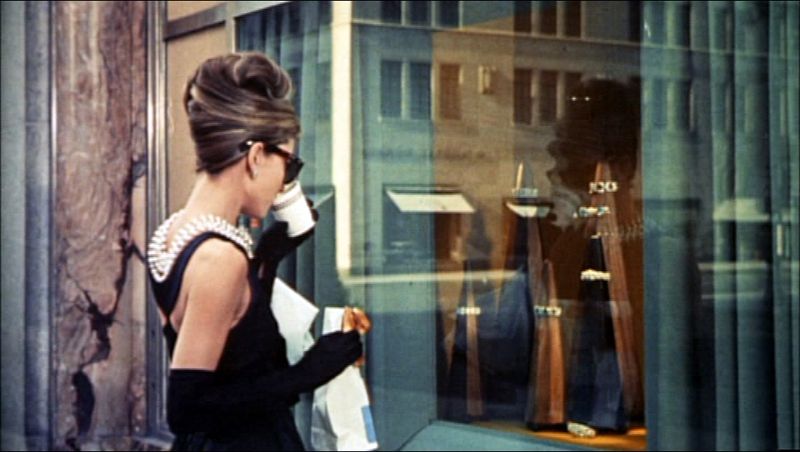
From her flirtatious shenanigans to her sentimental moments, Audrey Hepburn as the vivacious, cunning, yet ditsy socialite Holly Golightly fills Breakfast at Tiffany’s — one of the most beloved New York movies ever filmed — with memorable scenes. Who could forget the unforgettable opening where she has her breakfast in front of the jewelry store, Tiffany & Company, where as she says, “nothing very bad could happen to you there”?
The inception of the Tiffany & Company can be traced back to Brooklyn, Connecticut in 1837, where the company was founded by Charles Lewis Tiffany and John B. Young under the name Tiffany, Young and Ellis. The name was altered to Tiffany & Company in 1853 when Charles Tiffany took over, and since 1940, their flagship store has been on the corner of Fifth Avenue and 57th street.
When the building opened 75 years ago, the 24-foot-high, column-less ceiling was an impressive engineering feat unto itself. Moreover, the flagship store of Tiffany & Company was the first commercial building in New York City with central air-conditioning. Interestingly, the Atlas Clock perched outside of the store is older than the store. It was originally mounted on top of another Tiffany & Company store at 550 Broadway in 1853 before being moved to the company’s flagship location upon its construction.
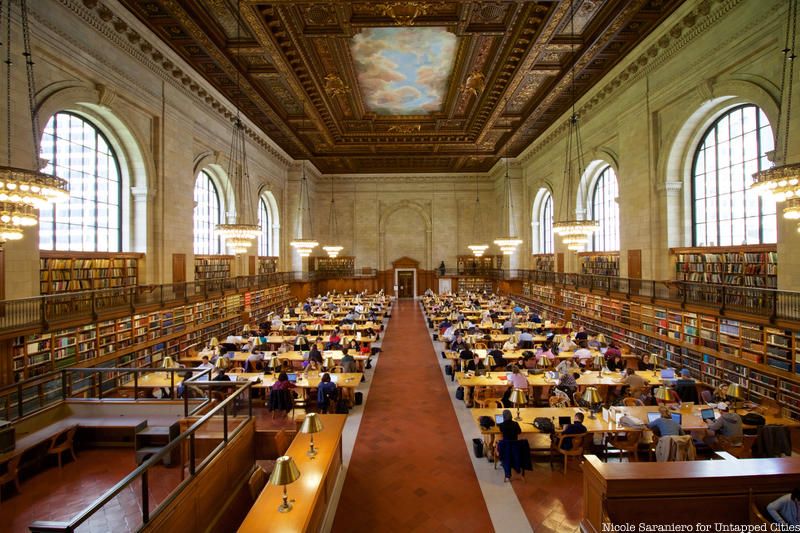
Opening with a shot of the marble lions and followed by their first ghost encounter in the reading room, this memorable scene in Ghostbusters — one of the most famous New York movies filmed in the ’80s — occurred in the New York Public Library. While the scene was actually shot in the Los Angeles Central Library, it engendered considerable prominence for the New York Public Library.
One of the prominent features of the library is the two lions—who flank the steps of the main entrance. According to the book, The New York Public Library: The Architecture and Decoration of the Stephen A. Schwarzman Building, the commission for the lions was obtained by Edward Clark Potter, who modeled them on the recommendation of Augustus Saint-Gauden, one of America’s foremost sculptors. The lions have become a distinguished hallmark of the library, visited and photographed by countless tourists and featured in numerous motion pictures and television shows.
Interestingly, their nicknames have changed over the decades. Originally, they were called Lea Astor and Leo Lenox, after the New York Public Library founders John Jacob Astor and James Lenox. Later, they were regarded as Lady Astor and Lord Lenox. During the 1930s, Mayor Fiorello LaGuardia named them Patience and Fortitude, as he believed these were the qualities New Yorkers would need to survive the economic depression. These names have stood the test of time, as have the lions, such that the library has adopted them as its mascots.
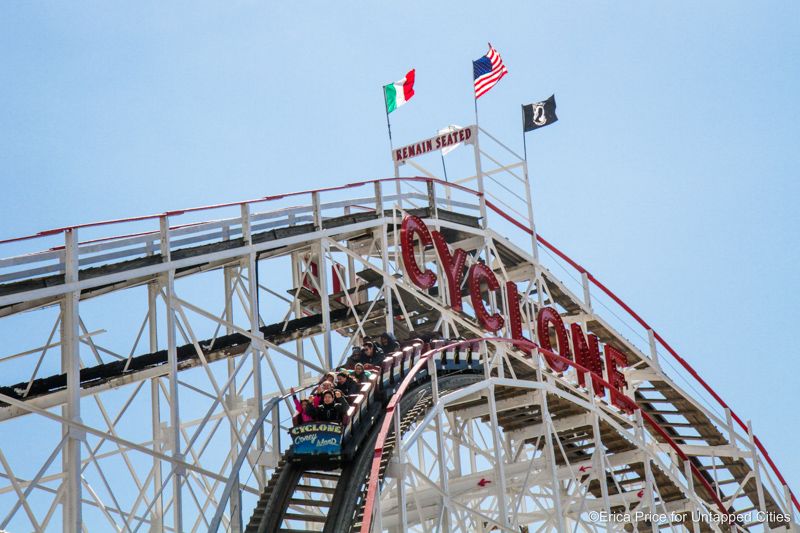
In one of the most famous cult New York movies, The Warriors, a gang from Coney Island must battle their way from the Bronx through numerous rival gangs’ turf back home after being framed for murder. The movie was shot almost entirely at various sites on the streets of the city—an arduous and complicated task that involved shooting from sun down to sunrise virtually every night, inclusion of real gang members, and confrontations with actual gang members. In the last scene the Warriors return to Coney Island for a final confrontation with the Rogues.
As the Warriors pass through Coney Island, there are several noticeable buildings and landmarks featured in the scenes. Stauch’s Bathhouse was one of the many bathhouses along the boardwalk, and was openly known as a gay hangout during the Depression. The abandoned building was featured in many scenes that were later cut out of the movie. In fact, the Warriors name was graffitied across the front of the building until it was torn down in the 1980s. Moreover, in another scene, the Cyclone can be seen in the background.
The Cyclone, constructed in 1927, is one of the oldest wooden coasters still in operation. The only scene in the movie that was filmed outdoors during the day is the climatic final confrontation that occurs on the beach of Coney Island.

From canon ball jumping into the pool to gorging on a medley of delicious deserts, it’s fair to say Kevin McAllister thoroughly enjoyed his stay at the “Park Plaza Hotel” in Home Alone 2. one of the most hilarious New York movies ever filmed, The Plaza Hotel, is a 20-story luxury hotel on the corner of 5th Avenue and 58th Street. When the French Renaissance château-style building first opened in 1907, a room at the Plaza Hotel was only $2.50 per night, the equivalent of $63 today. The same room would cost as much as 15 times that now.
The Plaza Hotel has a long and decorated history of being used by dignitaries and celebrities. The Persian Room has been the site of performances by numerous national singers such as the Mills Brothers, Peggy Lee, Patti Page, etc. More relevant to today’s news, in 1993 the ballroom hosted Donald Trump’s wedding to Marla Maples in front of 1,500 guests.
Throughout the years the Plaza Hotel has changed hands numerous times. It was, for a time, owned by Trump, who famously said, “I haven’t purchased a building, I have purchased a masterpiece.” After multiple renovations—which saw the addition of private condo hotel units—and changes of ownership, the Plaza Hotel is currently owned by Qatar-based Katara Hospitality.

As Stephanie and Tony Manero sit by the waterfront looking at the Verrazano Narrows Bridge in the 1977 blockbuster Saturday Night Fever, Tony recites a series of facts about the bridge, with his last claim about the bridge being, “there’s a guy buried in the cement.” While no one is buried in the structure’s foundation, there is no refuting the other very interesting facts about the Verrazano Narrows Bridge.
Original discussions to connect Brooklyn and Staten Island began back in 1888—yet that was for a tunnel. Digging even began before the tunnels were abandoned, nicknamed “Hylan’s Holes” after the Mayor of the time, John F. Hylan. Deliberation between a tunnel or a bridge prolonged until 1946, when Robert Moses became serious about building a bridge; it was the last great public works project in New York City to be overseen by him.
Construction of the bridge lasted five years—quite long compared to the Empire State Building, which was completed 33 years before Verrazano in one year and 45 days. Upon completion in 1964, the bridge became the world’s longest suspension bridge in the world. While it currently ranks 17th, Verrazano is still the longest one in the United States. The Verrazano Narrows Bridge contributed tremendously to Staten Island’s development and population growth. The population doubled from about to 221,000 in 1960 to 443,000 in 2000, as many undeveloped areas in the south and southeast area of the island grew.

One of the quintessential scenes in the Godfather movies takes place on Mulberry Street in Little Italy, where a young Vito Corleone assassinates Don Fanucci, a “blackhander” extortionist—amidst the celebration and revelry of the Feast of San Gennaro.
Currently an 11-day street fair in mid-September, laden with drinks, food, and even a cannoli-eating contest, the Feast of San Gennaro started off as a one-day religious commemoration which initiated in 1926 when immigrants from Naples congregated along Mulberry Street to continue the Italian tradition of celebrating Saint Januarius, the Patron Saint of Naples. During the first years of the feast café owners would erect a small chapel in the street that would host the image of their patron Saint. Partakers in the feast were asked to pin a small offering to the Chapel—money that would be then distributed to the poor and needy. Currently, on the last Saturday of the event, a Roman Catholic candlelit Grand Procession is held and the statue of San Gennaro is carried through the streets of Little Italy, just like in The Godfather.
While no incidents akin to the Godfather scene have occurred during the feast, in 1994 Mayor Giuliani declared that if the San Gennaro festival did not remove corrupt elements, namely financial improprieties and mafia involvement, he would shut it down.
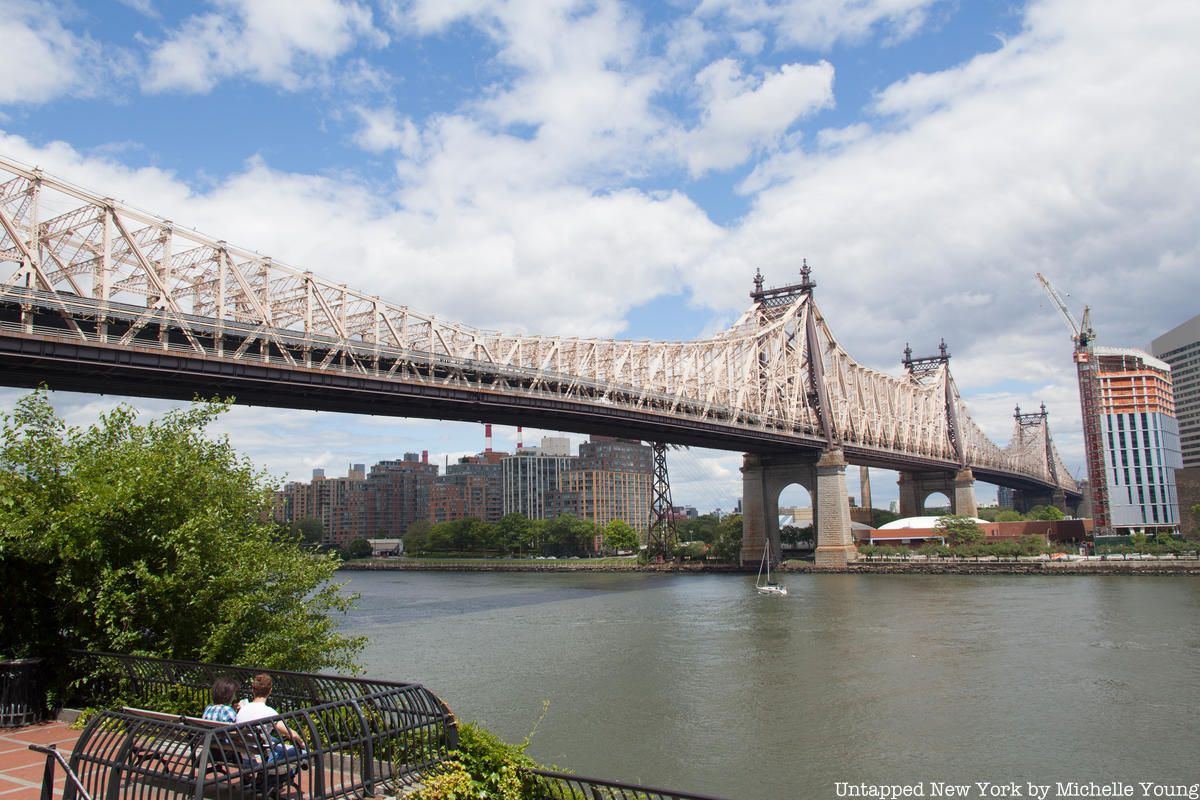
Woody Allen’s love for New York City is aptly captured in Manhattan, one of the director’s earliest New York movies, when, while sitting on a park bench under the 59th Street Bridge (Queensboro Bridge) with Mary Wilkie (Diane Keaton) Woody Allen’s character Isaac proclaims, “This is really a great city. I don’t care what anyone says. It’s really a knockout, you know?” Perhaps it is because of this love for the city that he opted to shoot the movie’s most memorable scene—which was also on the movie poster—at 5 a.m. at Sutton Place, a secluded, tucked-away little park on the waterfront of the East River.
Completed in 1909, the Ed Koch Queensboro Bridge (the bridge was officially renamed from simply Queensboro Bridge in 2011) is a double cantilever bridge that was the largest cantilever bridge in North America, before being surpassed in 1917 by the Quebec Bridge. The bridge originally contained two pedestrian walks and two elevated railways tracks on the upper deck, while the lower deck comprised four motor traffic lanes and two trolley lanes, which are now the pedestrian and biking lanes.
The bridge is featured in numerous pictures, and some literature, including The Great Gatsby in which, while Jay Gatsby and Nick Carraway traverse the bridge, Nick says, “The city seen from the Queensboro Bridge is always the city seen for the first time, in its first wild promise of all the mystery and the beauty in the world”.
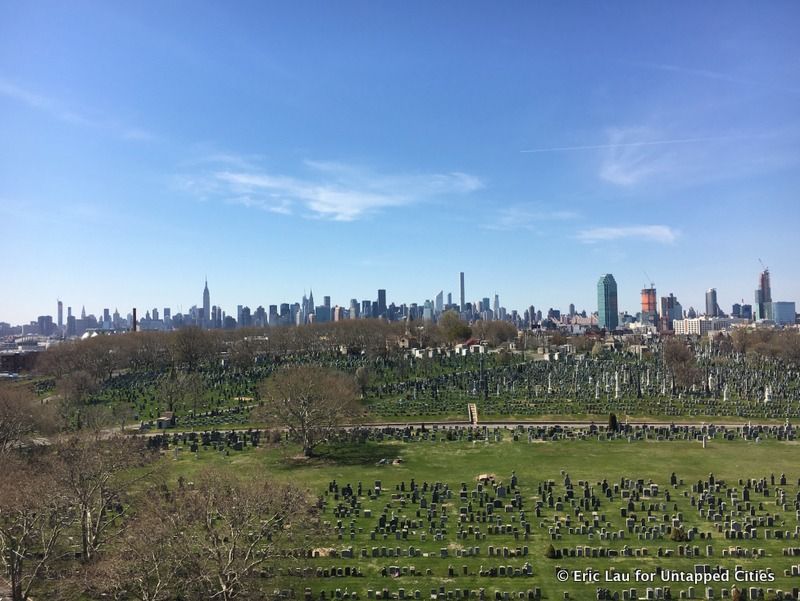
The Calvary Cemetery located in Maspeth and Woodside, Queens, is one of the oldest cemeteries in the United States. The Old Calvary (the oldest section of the cemetery) was constructed in 1848. Since then nearly 3 million people have been buried there, including numerous famous, and infamous characters ranging from organized crime figures, to generals, and athletes.
This historic cemetery has been featured in a few New York movies, but is perhaps most prominent for hosting the funeral scene of Don Carleone in The Godfather (perhaps one of the greatest New York movies ever filmed). The towering tombs and monuments of the cemetery truly add a sobering element to the movie. Moreover, the cemetery was also used in a famous scene in the movie Zoolander.
The cemetery’s first inhabitant was Esther Ennis, who was said to have died of a “broken heart” on July 31st, 1848. By 1852, there were 50 burials a day, half of them poor Irish under the age of seven.

Propelled to prominence by its cameo in You’ve Got Mail starring Meg Ryan and Tom Hanks, Café Lalo is a desert bar located on West 83rd Street between Broadway and Amsterdam avenues. The café’s European-style floor-to-ceiling front windows, along with its 70 different types of cake and cheesecake make it a very popular spot on the Upper West Side—especially given the cafe’s late night hours. Cafe Lalo is particularly popular with fans of the movie who want to visit the site of the memorable exchange between Meg Ryan and Tom Hanks.
However, as early as 2016, DNAinfo reported the café wasn’t doing well, and that the owner Haim Lalo said he may have to close due to bad business. The café’s woes have worsened by the pandemic. In December 2020, West Side Rag reported that it’s been closed for the duration of the pandemic. No word of when—or if—it will reopen.
Next, see more from our Film Locations column, in which we dig up more film locations in NYC!
Subscribe to our newsletter